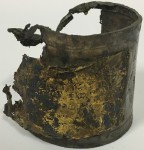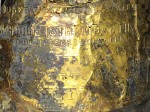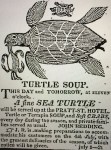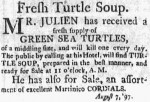 When researchers surveying a new railway tunnel being constructed in Delft, Netherlands, saw a yellow gleam, at first they thought it might be gold. In fact it was a tin can wrapped in a brass sleeve that still shines gold in color if not in material. The brass wrapper has a repoussé label identifying it as “Preserved foods, W. Hoogenstraaten and Sons, purveyor, turtle soup, Leiden.” W. Hoogenstraaten and Sons changed its name in 1900, so the can has to date from 1860 to 1900.
When researchers surveying a new railway tunnel being constructed in Delft, Netherlands, saw a yellow gleam, at first they thought it might be gold. In fact it was a tin can wrapped in a brass sleeve that still shines gold in color if not in material. The brass wrapper has a repoussé label identifying it as “Preserved foods, W. Hoogenstraaten and Sons, purveyor, turtle soup, Leiden.” W. Hoogenstraaten and Sons changed its name in 1900, so the can has to date from 1860 to 1900.
 An old, damaged tin can may not seem like much of an archaeological discovery, but in its day this product was very high-end, hence the fancy metalwork label. Turtle soup was a refined food, even when canned, the kind of product only found in the pantries of the wealthy. It had been a staple on the menus of the most exclusive eateries and catered affairs since the 18th century. It was on the menu at the celebration of King William III’s 70th birthday in Amsterdam on April 23rd, 1887.
An old, damaged tin can may not seem like much of an archaeological discovery, but in its day this product was very high-end, hence the fancy metalwork label. Turtle soup was a refined food, even when canned, the kind of product only found in the pantries of the wealthy. It had been a staple on the menus of the most exclusive eateries and catered affairs since the 18th century. It was on the menu at the celebration of King William III’s 70th birthday in Amsterdam on April 23rd, 1887.
 In the US it was a popular dish for elite even before there was a United States. John Adams recorded eating it several times at the Continental Congress. Other Founding Fathers including George Washington, Alexander Hamilton and Aaron Burr, were members of a club, the Hoboken Turtle Club, dedicated to eating turtle soup. It made regular appearances at Fourth of July celebrations in the 19th century. President Abraham Lincoln served it at his 1861 inauguration and President William Howard Taft had it as often as possible when he was in the White House from 1909 to 1913. It was so desirable in the Victorian era and so out of reach for people without an unlimited budget that mock turtle soup became a thing. A nice, cheap calf’s head was used in place of the amphibian flesh.
In the US it was a popular dish for elite even before there was a United States. John Adams recorded eating it several times at the Continental Congress. Other Founding Fathers including George Washington, Alexander Hamilton and Aaron Burr, were members of a club, the Hoboken Turtle Club, dedicated to eating turtle soup. It made regular appearances at Fourth of July celebrations in the 19th century. President Abraham Lincoln served it at his 1861 inauguration and President William Howard Taft had it as often as possible when he was in the White House from 1909 to 1913. It was so desirable in the Victorian era and so out of reach for people without an unlimited budget that mock turtle soup became a thing. A nice, cheap calf’s head was used in place of the amphibian flesh.
 It wasn’t just a delicacy for gourmands, however. Turtle soup was believed to have medicinal properties. Famed Swiss doctor Samuel-Auguste Tissot had a high opinion of turtle soup, even though it proved incapable of curing the effects of one of the greatest ills ever to afflict the human body: masturbation. In his 1760 treatise Onanism: on the Diseases Caused by Masturbation, Tissot described ejaculation was a kind of epilepsy, a violent spasm that expelled more than mere semen, leaving the body weakened and the brain and nervous system dangerously debilitated. Masturbation caused gout, headaches, apoplexy, blood in the urine, nervous disorders and pretty much everything else. One of his unfortunate patients, a college student, masturbated so much he gave himself tuberculosis. His loud, hard coughs, a classic symptom of onanism, woke up the neighbors.
It wasn’t just a delicacy for gourmands, however. Turtle soup was believed to have medicinal properties. Famed Swiss doctor Samuel-Auguste Tissot had a high opinion of turtle soup, even though it proved incapable of curing the effects of one of the greatest ills ever to afflict the human body: masturbation. In his 1760 treatise Onanism: on the Diseases Caused by Masturbation, Tissot described ejaculation was a kind of epilepsy, a violent spasm that expelled more than mere semen, leaving the body weakened and the brain and nervous system dangerously debilitated. Masturbation caused gout, headaches, apoplexy, blood in the urine, nervous disorders and pretty much everything else. One of his unfortunate patients, a college student, masturbated so much he gave himself tuberculosis. His loud, hard coughs, a classic symptom of onanism, woke up the neighbors.
He was frequently bled, doubtless to relieve his sufferings. A consultation of physicians was called; they prescribed turtle soup and a return home, as he was a native of Dauphiny, and promised him a perfect cure. He died two hours later.
Apparently not even turtle soup could counter the pernicious effect of wanking (or of draining the blood of a late-stage tuberculosis patient).
 Tissot’s prescription was widely endorsed, even directly cited by the purveyors of fine viands. Turtle soup was the house specialty at Julien’s Restorator, established in 1793 as one of the first restaurants in Boston, which billed itself as a spa-like health resort where the convalescent would find a restful environment and proper nourishment. Julien’s advertised the soup in the papers emphasizing its ostensible curative abilities.
Tissot’s prescription was widely endorsed, even directly cited by the purveyors of fine viands. Turtle soup was the house specialty at Julien’s Restorator, established in 1793 as one of the first restaurants in Boston, which billed itself as a spa-like health resort where the convalescent would find a restful environment and proper nourishment. Julien’s advertised the soup in the papers emphasizing its ostensible curative abilities.
Turtle soup. Much has been said on its efficacy in purifying the blood by Tissot in his celebrated dissertation on the subject, and by Buffon, the great naturalist, who discovered the beneficial nature of amphibious animals. Those who use this soup must not expect that it be made strong with spice, but from ingredients clear and light.
Many celebrated physicians have recommended it. … As the first establishment of a restorator in Paris was not for Epicurians — but for the benefit of those invalids who stood in need of light substance, nourishing and strengthening to their stomacks, it was recommended for the purpose by the Academy in Paris. Citizens of the above description are invited to call and try the virtue of Julien’s turtle soup.
Turtle soup is illegal in Europe now because the main ingredient is an endangered species. It can still be found on US menus made from freshwater or farmed turtles — it’s a standard in Cajun cuisine wherein, unlike at Julien’s Restorator, it’s definitely “made strong with spice” — but generally speaking the taste for it faded after World War II. That raggedy tin can in Delft truly captures a bygone era.